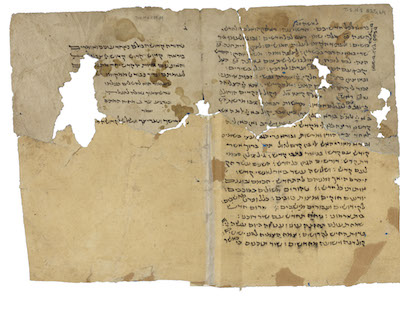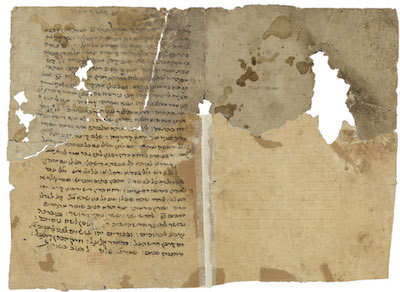Addendum to November 2011's Fragment of the Month
by Michael Rand
Since the appearance of this FOTM, it has become possible to augment the reconstruction of the First Order of Fusṭāṭ, thanks to my discovery of an oversight on my part, as well as the recent identification of a new fragment by Vered Raziel-Kretzmer. In the reconstruction given in November 2011's FOTM, I assumed a quire of five bifolia, and consequently surmised that the first quire was lacking its inner bifolium. It escaped my notice, however, that two more leaves belonging to this quire have been referred to in the literature: ENA 2501/5-6 (see E. Fleischer, 'שרידים נוספים מקובצי תפילה ארץ-ישראליים מן הגניזה' in idem, תפילות הקבע בישראל בהתהוותן ובהתגבשותן [Sh. Elizur and T. Beeri eds.; Jerusalem, Magnes, 2012] p. 711, note 42). These two leaves belong to a single bifolium. The first leaf (ENA 2501/5) is a direct continuation of the first group of three leaves in T-S H 12.11. The second leaf directly precedes the second group of three leaves in T-S H 12.11. These two leaves themselves are not continuous—i.e., my original assumption of a quire of five bifolia is incorrect, and the original quire seems to have been composed of six bifolia.
The second quire is reconstructed in the original FOTM on the basis of three manuscripts, two of which represent the outer bifolium: T-S 13 H 3.11 + T-S NS 325.69. The new fragment identified by Raziel-Kretzmer is T-S NS 139.88. This fragment represents the upper portion of the outer bifolium, which is now reconstructed in full. The newly identified fragment shows that the last leaf of the quire is not entirely blank as I had originally surmised, as material is copied at the top of the recto.
Here is an augmented version of the transcription given in the original FOTM, which incorporates the material from T-S NS 139.88:
- ויקול להקדים הודו לייָי
- כי טוב <יגיבו> כי לעולם חסדו. מרשות רבותי[נו] יגיבו מרשות הש'
- ב' א' ייָי אל' מ' ה' בורא הגפן. פאן כאן שבת יקול ב' א' ייָי אל' מ' ה' אשר
- קדשנו ורצה בנו אלי מקדש השבת. וישרב. ואן כאן לילה
- אלאחד יבדי הודו ומרשות ובורא פרי הגפן ועצי בשמים
- ובורא מאורי האש אלי בין קדוש לחול. תם בָּרוּךְ אֲשֶׁר
Notes
Line 4: וישרב] Fleischer had conjecturally reconstructed a compound benediction formula here: ... ויש[ראל וראשי חדשים]. However, the new fragment shows that the benediction formula refers only to the Sabbath, and that what he had taken as the beginning of the word וישראל is actually part of the Arabic instruction to drink the qiddush wine.
Line 6: קדוש] This is an error. The word should read קודש.
The new fragment has also added text to the poem by Sahlān b. Avraham, a revised edition of which has been published in an appendix to my article “New Data on Aramaic in Classical Piyyut – תשמיע ניחומים ללישה, a Silluq for Shabbat Shim‘u by Yoḥanan ha-Kohen,” Aramaic Studies 13 (2015) 128-60.
Cambridge University Library T-S 13H3.11 + T-S NS 325.69 + T-S NS 139.88
Cambridge University Library T-S 13H3.11 + T-S NS 325.69 + T-S NS 139.88
Cite this article
(2011). Addendum to November 2011's Fragment of the Month. [Genizah Research Unit, Fragment of the Month, November 2011 Addendum]. https://doi.org/10.17863/CAM.62327
If you enjoyed this Fragment of the Month, you can find others here.
Contact us: genizah@lib.cam.ac.uk
The zoomable images are produced using Cloud Zoom, a jQueryimage zoom plugin:
Cloud Zoom, Copyright (c) 2010, R Cecco, www.professorcloud.com
Licensed under the MIT License


